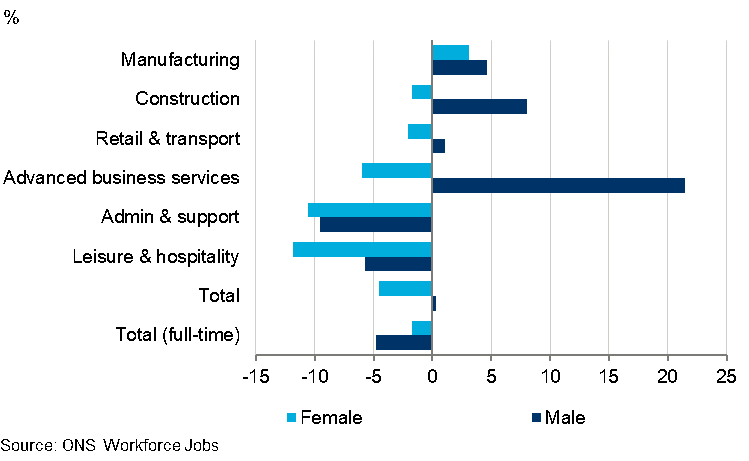Blog | 14 Jun 2021
How has the pandemic affected women in the labour market? Some evidence from the UK

There has been much discussion around the world about how the Covid pandemic is disproportionately impacting women in the labour market. A report from the OECD suggests that male-dominated policy-making bodies are making decisions that discriminate against women. Some commentators have gone so far as to call the current situation a “shecession.” Is that true?
It’s worth thinking about the ways in which the labour market may operate unfairly. Research published by the UK government identifies four barriers to women’s progression in the workplace: lack of flexible/part-time options, external responsibilities, pay and promotion biases, and hostile environments. We can use these to think about how the pandemic might be making the labour market tougher for women.
Regarding flexible options, it is clear that in the UK the pandemic has caused part-time jobs to be lost at a higher rate for women than full-time roles—unfortunate since more women than men rely on part-time work.
But what is striking, as the chart below shows, is that part-time employment fell faster for women than for men. Between December 2019 and December 2020, women’s part-time employment dropped by 4.6%—for men there was a marginal rise of 0.3%. And although in manufacturing part-time employment actually went up, that increase also more significantly favoured men. The most extreme case is advanced business services, which includes sectors such as advertising, legal services, computer programming and banking.
UK part-time employment (unless otherwise specified), Dec 2019 – Dec 2020, % change

There are several possible explanations for this. For one, it is possible that some men who have lost full-time jobs (as the chart above shows, full-time positions fell at a faster rate for men than for women) moved to part-time roles. But with schools closed and children required to remain at home, many women have likely abandoned part-time jobs. That could be because male partners have remained in better paid full-time jobs, or because of persistent expectations that where childcare is concerned, it is the woman who should make the sacrifice.
This connects to the second barrier—external responsibilities. This issue arises for many women who have shifted to working from home. For many, the increased flexibility and time-saving can ease pressures on the work/life balance. Indeed, recent polling showed 63% of women in the UK would strongly consider continuing at home after the pandemic, compared with 49% of men. Undoubtably this can be good if it means spending more time with family—and if that aligns with the women’s priorities. But these benefits are arguably the same for men.
So why are fewer men keen to continue working remotely? It is possible that the balance of unpaid home duties has further shifted during lockdown, with many women now expected to juggle more responsibility at home and at work, while men return to their offices.
Which leads to the matter of pay and promotion biases. We could see more women who want to progress being left behind—forgotten about at home—while the office-goers benefit from face-to-face connections. The research suggests that women may already be at a disadvantage in a male-dominated workplace, with “social cloning” (where those in higher up positions—typically men—promote those who are similar to themselves) and “boys club” networking key examples of this. If post-pandemic workplaces become more male, then the workplace could easily and rapidly become less friendly for women, creating a vicious spiral in which women are more likely to want to work from home. Ultimately, this may lead to an increasingly hostile environment for women, where issues such as gender stereotyping and isolating work cultures stifle women’s opportunities to progress.
The UK government research highlights a number studies describing the importance of support networks in easing the impacts felt within male-dominated working cultures. This is arguably more important now than ever: If companies are serious about equality in the workplace, we should actively encourage a strengthening and expanding of support networks for women, both in the office and at home.
Tags:
You may be interested in

Post
You don’t have to be an IT expert to lead on AI
The adoption curve for AI will vary across companies but, according to our data, it’s probably already in use in customer service and marketing—areas where women are more likely to hold leadership roles.
Find Out More
Post
The latest export from China is … deflation
We expect Chinese export price deflation to provide a helpful tailwind in the struggle to bring EM inflation back to target.
Find Out More
Post
Wheat prices soften in 2024, but risks tilted to the upside
Households have been grappling with sharply higher food bills over the past couple of years because of rocketing agricultural commodity prices, which have contributed to sharply higher inflation globally. Key amongst these agricultural commodities is the price of wheat, which is especially important in much of the developed world.
Find Out More